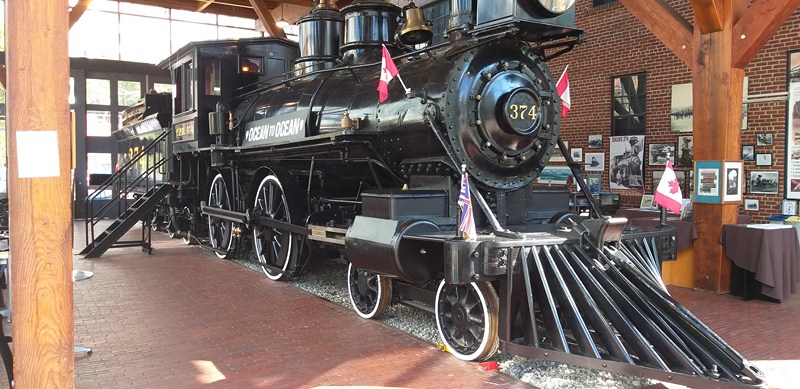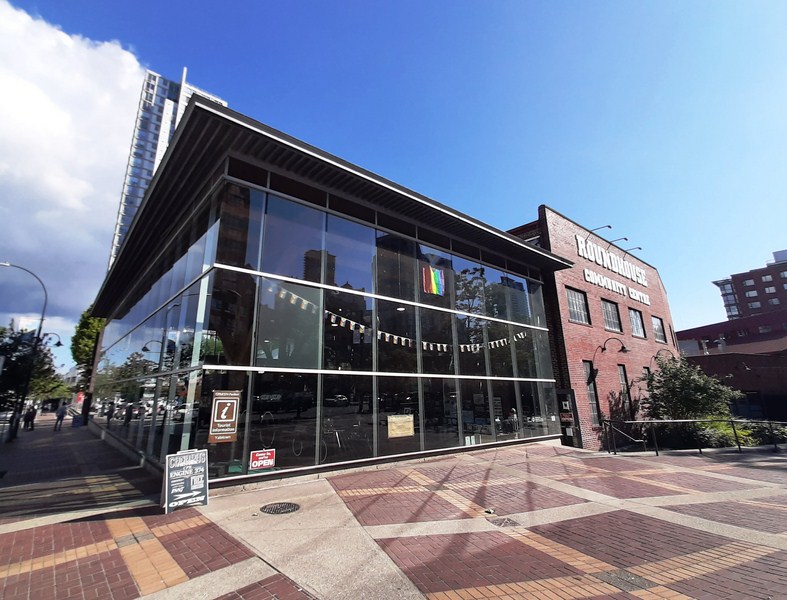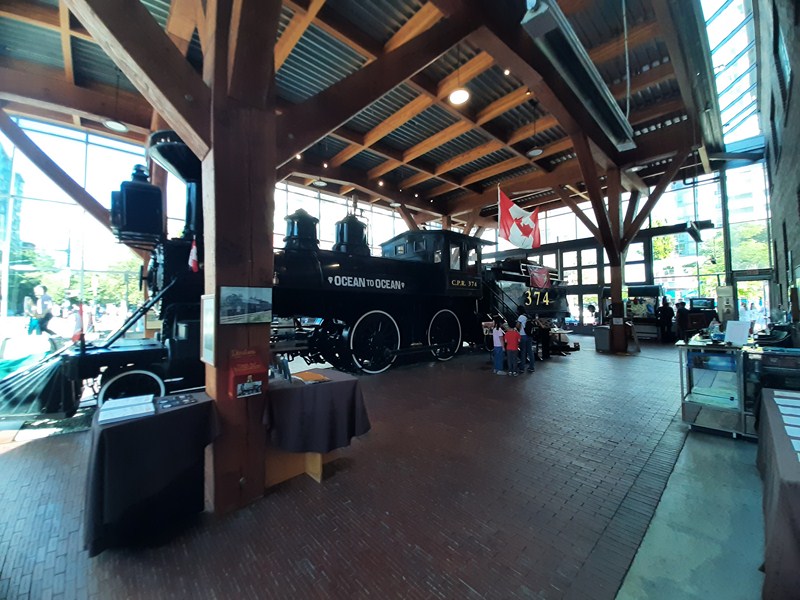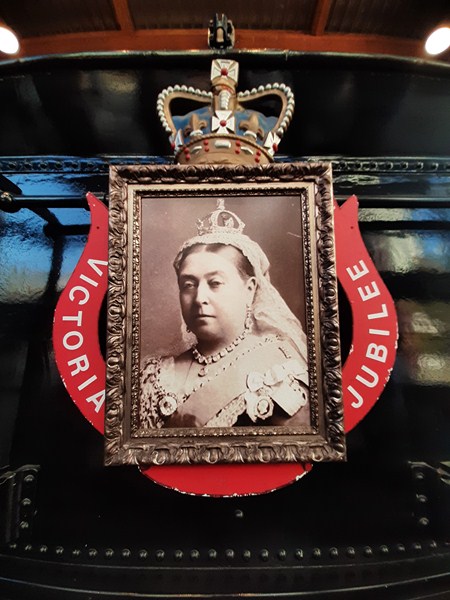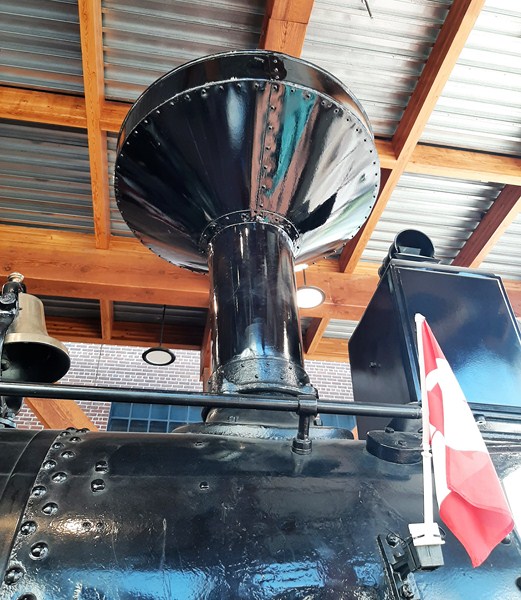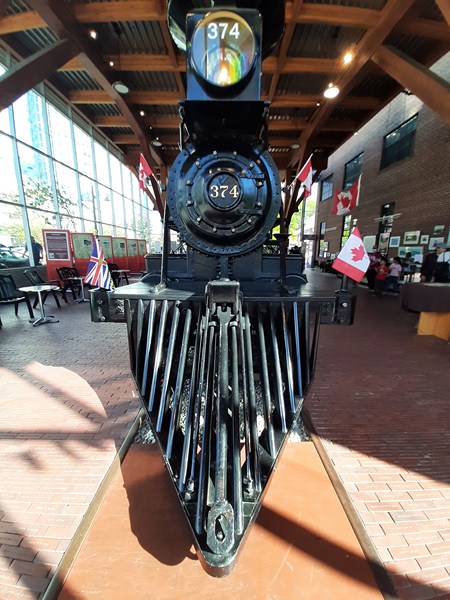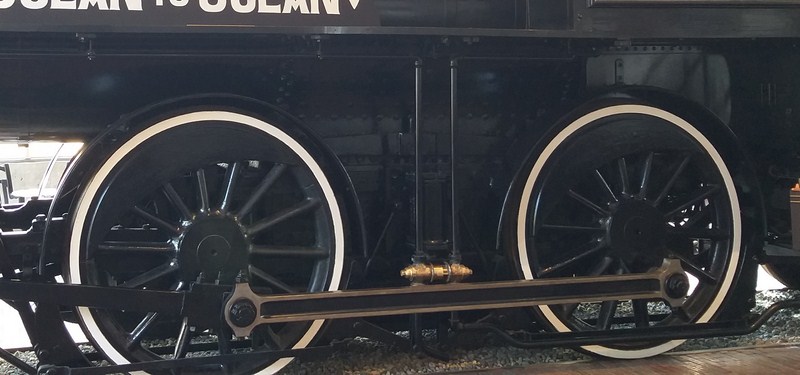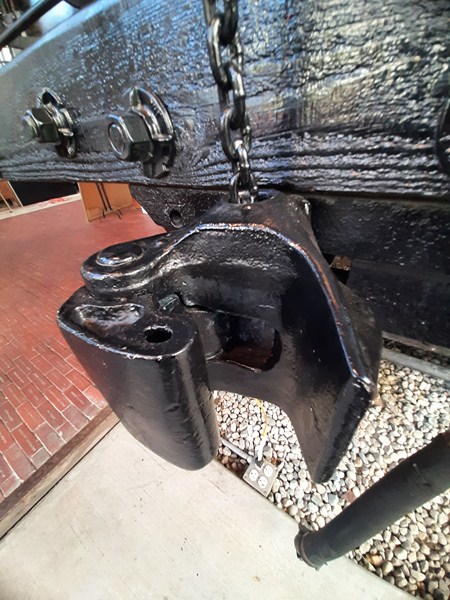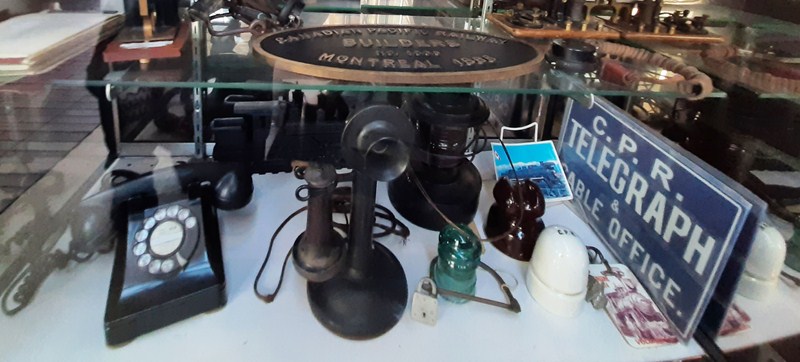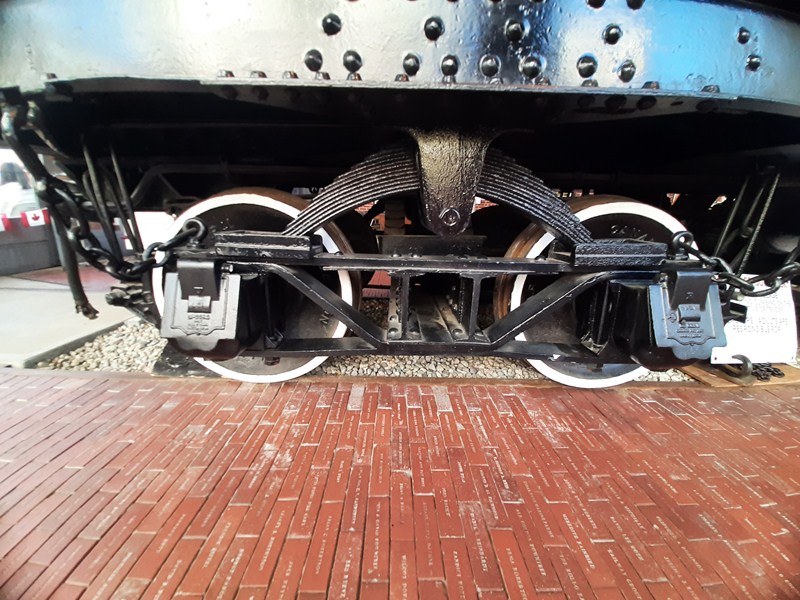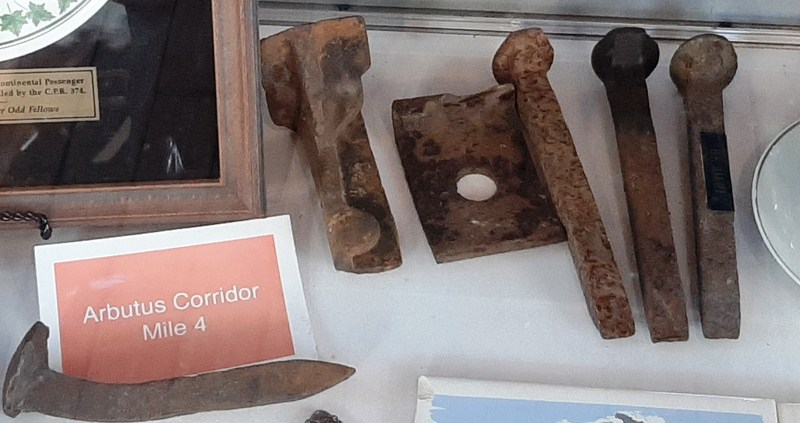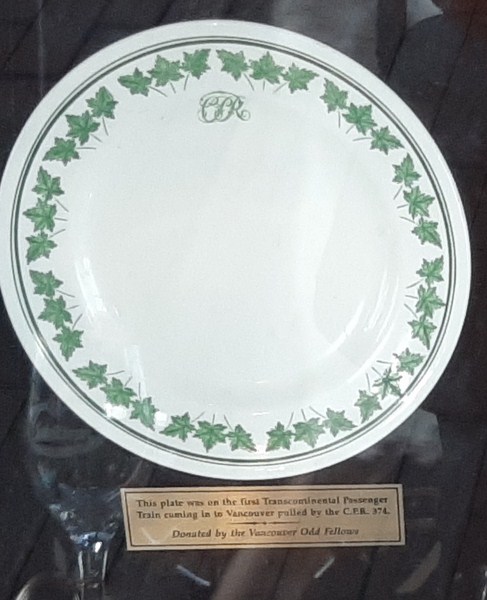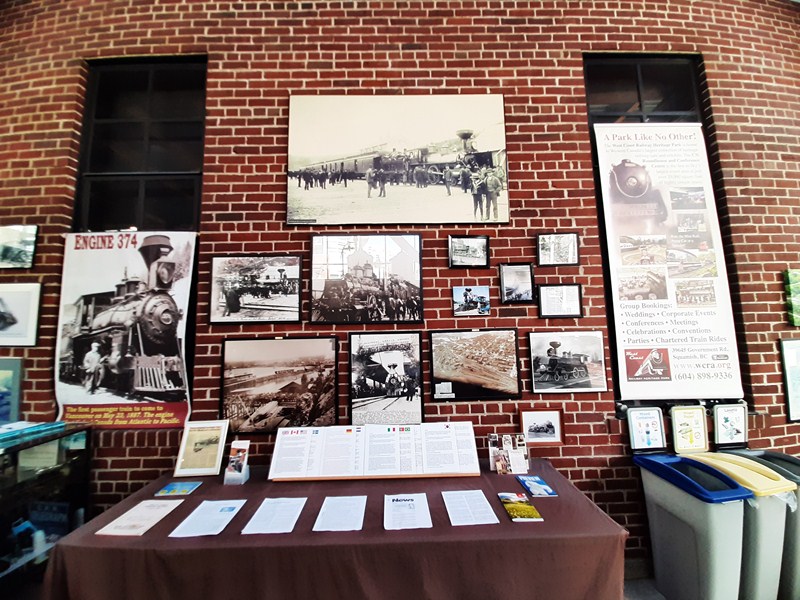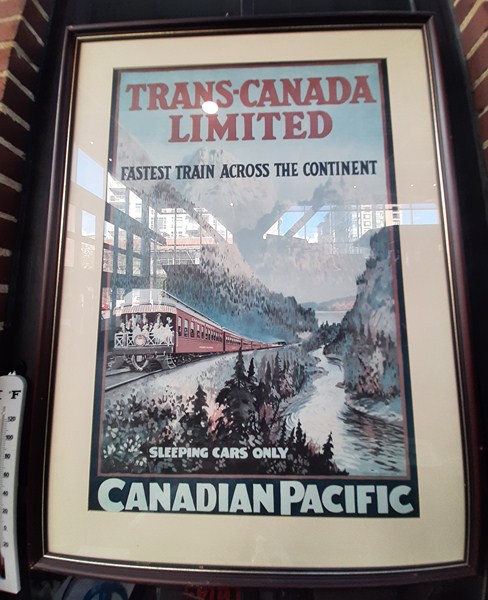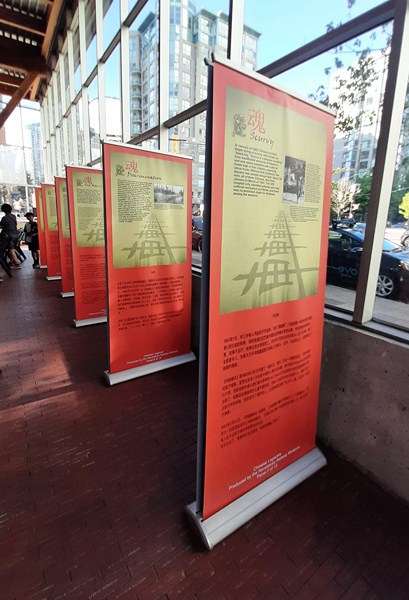After buying shoes at MacArthur Glen Designer Outlet, Grace, Jandy, Kyle and I again boarded the SkyTrain from Templeton Station to Yaletown-Roundhouse. Upon arrival at the station, we just walked about 250 m. to get the Engine 374 Pavilion, along the shores of False Creek in Yaletown.
It houses a static display of historic Engine No. 374, a Canadian Pacific Railway (CPR) steam locomotive that pulled the first transcontinental train (carrying 150 passengers) that arrived in Vancouver on May 23, 1887, finally joining Canada from the East Coast to Vancouver on the West Coast.
This ten months after sister Engine No. 371 brought the first train to cross Canada into Port Moody on July 4, 1886, roughly 32 kms. (20 mi.) to the east.
It was renumbered three times – 374 until 1907, 92 until 1909, 245 until 1913, 158 until 1945. Originally, it was equipped with a “diamond” smokestack but, when it got to British Columbia, it was swapped for a familiar “sunflower” stack.
Engine No. 374 was built in May 1886 by the Montreal shops of CPR, one of eight (371 to 378) similar steam locomotives (with 4-4-0 wheel arrangement and having 69-in. driving wheels) built that year. In the 1890s, the 69” drive wheels were replaced with 62” ones for better traction.
While No. 371 was scrapped in October 1915, No. 374 was completely rebuilt in September 1914 and continued in service until July 1945.
Because of its historical significance, upon its retirement, it was donated to the City of Vancouver on August 22, 1945. It was placed on display on a section of track in Kitsilano Beach Park, remaining there until 1983.
Due to exposure to the salt air and a lack of upkeep, it suffered greatly. In 1963, a vain attempt was made to move it into the former aircraft hangar (now the Community Music School) in Vanier Park.
In 1981, the West Coast Railway Association (WCRA), a group of railway enthusiasts, launched an effort to restore the engine.
The locomotive was moved from Kitsilano and placed in a warehouse in Granville Island where dedicated volunteers restored it to its former glory. In 1985, the engine was transported North Vancouver’s Versatile Shipyards for final restoration in time for Expo 86.
On February 13, 1986, the refurbished Engine No. 374 was transported to the renovated former CPR Drake Street Roundhouse where it was put on display on the turntable and became a prime attraction.
After the Expo, the engine was placed inside the Roundhouse. In May 1988, volunteers were allowed access to examine, clean and polish the engine and set up arrangements for a public opening.
In 1988, the Expo 86 site, including the Drake Street Roundhouse, was sold to Concord Pacific, and, in the course of the False Creek North Development Plan, the developer agreed to convert and expand the buildings to comprise the Roundhouse Community Centre (designed by Baker McGarva Hart and completed in 1997).

AAR knuckle coupler or Janney are semi-automatic form of railway coupling that allows rail cars and locomotives to be securely linked together without rail workers having to get between the vehicles
Before the Roundhouse was converted, successful fundraising efforts were undertaken by the Vancouver Parks Board and the Lions Club, among others, to build a new building adjacent to the Roundhouse house Engine No. 374. The new building was inaugurated on August 22, 1997.
Part of the floor of the building consists of 20,000 “Heritage” bricks which are engraved with the names of individuals who bought one brick (for $19.86 each), which raised funds (totaling $400,000) through the unique Heritage Brick Program sponsored by Imperial Oil Limited. You can climb on board the cab and ring the bell.
Here are the engines’ specifications:
- Whyte notation: 4-4-0
- UIC classification: 2′B
- Gauge: 1,435 mm. (4 ft. 8+1⁄2 in.) standard gauge
- Driver diameter: 1,600 mm. (63 in.)
- Adhesive weight: 71,000 lbs. (32 tons)
- Locomotive weight: 115,000 lbs. (52 tons)
- Boiler pressure: 1.1 MPa (160 psi)
- Cylinders: Two
- Cylinder size: 430 mm. × 610 mm. (17 in. × 24 in.)
- Tractive effort: 67 kN (15,000 lbf)
- Factor of adhesion: 4.73
The pavilion, now a central feature of the Yaletown area redevelopment, is staffed entirely by volunteers from the West Coast Railway Association and, on average, sees roughly 41,000 visitors per year as of 2015.
An anniversary celebration is held annually on the Sunday before Victoria Day. The WCRA also runs the Railway Museum of British Columbia up in Squamish.
Check out “Railway Museum of British Columbia: CN Roundhouse and Conference Center,” “Railway Museum of British Columbia: Pacific Great Eastern Car Shop” and “Railway Museum of British Columbia: Railyard”
Also on display old CPR Engine 374 photos and posters; a miniature railway village; model trains; old telegraph set, signages; old telephones, fine china used on the train; Arbutus Corridor railroad spikes; AAR Knuckle Coupler; etc.
There’s also a gift shop selling souvenir Tshirts, mugs, plates and caps; train whistles; postcards; etc.
The “Chinese Legacies: Building the Canadian Pacific Railway” Exhibit, circulated by the Revelstoke Railway Museum, explores the story of the Chinese laborers during the construction of the Canadian Pacific Railway’s transcontinental line, in the 1880s, the lasting impact it had on their lives, as well as their contribution to Canadian national development.
Engine 374 Pavilion: 181 Roundhouse Mews, Vancouver, British Columbia V6Z 2W3. E-mail: info@wcra.org. Website: www.wcra.org. Tel: (604) 713-1800. Open Wednesdays to Sundays, 10 AM to 4 PM during the summer and 11 AM to 3 PM in the winter. Admission is free.

